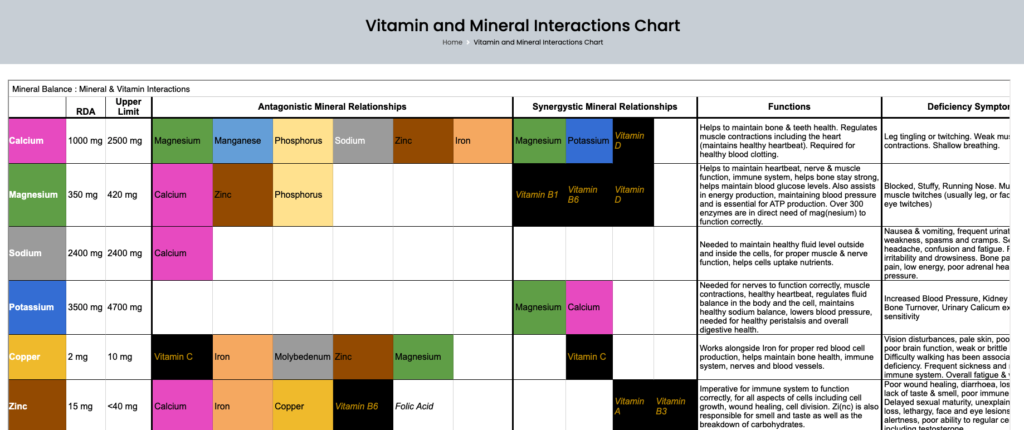This site is not intended to provide medical advice. Any information provided is purely for entertainment purposes. Always speak to your doctor before beginning a new health regime. Sponsored products may help maintain the costs of this site without costing you extra.
Mineral Balancing
If you’re familiar with holistic health you may have encountered the term mineral balancing, but what exactly is it? Mineral balancing is the name given to the homeostasis of essential minerals within the human body. It is widely accepted that humans have between 13 and 15 essential minerals although there is no exact number defined. Balancing minerals is an absolutely key requirement to maintain optimal human health. Under perfect circumstances your body will maintain mineral balancing without the need of significant interference. However thanks to the many known ills of modern life this isn’t always possible.
I may link to recommended products anywhere on this site, these links may earn me money that contributes to the maintenance of this site, but will not cost you anything extra.

What are the essential minerals in the body?
The following are most commonly listed as essential minerals within the body:
- Calcium
- Magnesium
- Sodium
- Potassium
- Iron
- Manganese
- Chlorine
- Iodine
- Zinc
- Phosphorus
- Molybdenum
- Copper
- Chromium
- Selenium
- Cobalt
Of the 15 or so essential minerals it is generally accepted that 5 are considered major. These are Calcium, Magnesium, Phosphorus, Sodium & Potassium. Other than phosphorus, which is found in great abundance, the remaining four minerals are known as electrolytes. These electrolytes have to be kept in a careful balance in order to maintain good health. The further remaining minerals are known as trace minerals due to the relatively small quantities of them that are needed in our body. The trace minerals that are considered to be required in the body are; iodine, molybdenum, zinc, copper, cobalt, chorine, iron, manganese, selenium and sulphur.
Being that minerals are elements they cannot be synthesised by the human body and must be ingested in some form or another. Our normal means of ingesting these essential minerals or elements is through eating food and drinking water. Both of which contain varying amounts of either minerals or elements depending on its composition. Our daily consumption of foods plays the biggest part in mineral balancing.
Why are minerals important in the body?
Minerals are important in the body as much as they are essential. Without minerals our bodies wouldn’t be able to perform the almost countless number of processes that simply keep us alive. Although it is widely considered acceptable to get all of the necessary mineral through diet alone this is becoming increasingly challenging. Too much or not enough of any mineral can have a noticeably detrimental effect on overall health. Whilst the amounts that we ingest of any mineral is important, what’s more important is both the bioavailability and the ratios between minerals. In addition because bioavailability is very closely determined by the ratios of minerals we can surmise that the ratios between minerals is the key factor to good health. This is where the role of mineral balancing stems from.
What function do minerals play within the body?
Each mineral is responsible for multiple functions in the body with some playing more significant roles than others. Certain mineral functions are more well known to the general public than others.
For example calcium is readily known to be responsible for good bone health. However did you know calcium plays a large role in maintaining good cardiovascular health? Now you can think about that next time you eat some cheese or drink a glass of milk. Magnesium on the other hand is commonly used to treat insomnia type symptoms as well as constipation. If any of you are unfortunate enough to have ever tasted milk of magnesia then you’ll know the explosive effects of this powerful mineral! However did you know magnesium helps your body perform over 300 biochemical processes including maintain normal nerve and muscle function? Iron is well known to reduce fatigue in the body as well as maintain normal red blood cell health. Although a lesser known function of iron is to convert blood sugar to energy.
“Now you may be thinking, who knew each mineral played such an important and diverse role within our bodies? Well that’s the beauty of the incredibly complex biological machine that is the human body!”
What does each mineral do for the body?

Now we know that minerals can have multiple important roles within the body it can quickly become a tangled web of information. If only there was a way of finding a full list of mineral functions within the body. Mineral Balance has answered those questions. Below is a full and rather exhaustive list of all the essential minerals, their purpose within the body, the food sources where they are found, and in what doses they are required. Here you can find a full list of which minerals the body needs. Furthermore you can find which minerals you need to ingest on a daily basis and how much you need.
| Mineral | Function | Source | RDA |
|---|---|---|---|
| Magnesium | Helps to maintain heartbeat, nerve & muscle function, immune system, helps bone stay strong, helps maintain blood glucose levels. Also assists in energy production, maintaining blood pressure and is essential for ATP production. Over 300 enzymes are in direct need of magnesium to function correctly. | Almonds, Spinach, Avocados, Potatoes, Brown Rice, Cashews, Pumpkin Seeds, Bananas, Dark Chocolate, Tuna. | ~400mg |
| Calcium | Helps to maintain bone & teeth health. Regulates muscle contractions including the heart (maintains healthy heartbeat). Required for healthy blood clotting. | Yogurt, Milk, Cheese, Nuts, Seeds, Legumes, Grains, Sardines, Salmon, Fortified Tofu, Green Leafy Vegetables. | ~1200mg |
| Potassium | Needed for nerves to function correctly, muscle contractions, healthy heartbeat, regulates fluid balance in the body and the cell, maintains healthy sodium balance, lowers blood pressure, needed for healthy peristalsis and overall digestive health. | White Beans, Bananas, Tomato, Beet, Salmon, Avocados, Milk, Spinach, Dried Apricots, Oranges. | ~3,500 to 4,700mg |
| Sodium | Needed to maintain healthy fluid level outside and inside the cells, for proper muscle & nerve function, helps cells uptake nutrients. | Salt, Pickled Foods, Soy Sauce (and similar condiments), Processed Foods. | Around 5grams (1tsp) |
| Phosphorus | Involved in the formation and maintenance of healthy bones & teeth. Also important for your protein synthesis, the maintenance of cells & tissue, as well as carbohydrate & fat metabolism. | Seeds, Cheese, Pork, Poultry, Tofu, Nuts, Beans, Fish, Beef, Yoghurt, Whole Grains. | ~700mg |
| Iodine | Essential in thyroid hormone production and maintenance. Thyroid hormone is important for numerous functions within the body. | Cranberries, Potatoes, Navy Beans, Cheese, Fish, Mussels, Shrimp, Sea Weed. | ~300 to 800μg |
| Zinc | Imperative for immune system to function correctly, for all aspects of cells including cell growth, wound healing, cell division. Zinc is also responsible for smell and taste as well as the breakdown of carbohydrates. | Oysters, Beef, Chicken, Tofu, Pork, Hemp Seeds, Pumpkin Seeds, Sesame Seeds, Lentils, Oatmeal, Shiitake Mushrooms. | ~8 to 25mg |
| Iron | Important for making red blood cells, oxygenates blood, converts blood sugar to energy, boosts immune system, helps with cognitive function, assists with healthy skin, hair & nails. | Red Meat, Dried Fruits, Kidney Beans, White Beans, Chickpeas, Nuts, Liver, Squash & Pumpkin Seeds. | ~8 to 15mg |
| Copper | Works alongside iron for proper red blood cell production, helps maintain bone health, immune system, nerves and blood vessels. | Kale, Liver, Mushrooms, Cheese, Whole Grains, Cashews, Prunes, Tempeh, Oysters, Chickpeas, Avocados. | ~1.0 to 1.6mg |
| Manganese | Helps to maintain bones and connective tissues. Responsible for proper blood clotting factors and sex hormone production. It has been known to assist calcium absorption, blood sugar regulation as well as normal nerve and brain function. | Sweet Potatoes, Spinach, Mussels, Tofu, Pine Nuts, Brown Rice, Chickpeas, Pineapple, Lima Beans. | ~1.8 to 2.3mg |
| Molybdenum | This mineral is used to process genetic material such as DNA and proteins. It helps to detox deadly toxins and sulfites that would otherwise build up in your body. | Legumes, Whole Grains, Nuts, Beef Liver, Cereal Grains, Leafy Vegetables, Milk. | 45 μg |
| Cobalt | Part of Vitamin B12 is comprised of cobalt. It assists in maintaining healthy nervous system and cells. It also helps with breaking down sugars, assisting in iron absorption and metabolism of fats and carbohydrates. | Green Leafy Vegetables including Cabbage, Lettuce, Spinach, Kale. Dried Fruits such as Apricots Raisins, Prunes, Dates. Seafood, Dairy & Meat. | 5 to 8 μg |
| Sulfur | Sulfur plays a major role in building and fixing DNA as well as protecting cells from a variety of damage. Sulfur is also important for healthy tendons, ligaments and skin. It is known to assist your body in the breaking down of certain foods as well as correct absorption. | Eggs, Dairy Products, Nuts & Seeds, Legumes, Broccoli, Kale, Cabbage, Cauliflower, Meat & Seafood. | N/A |
| Selenium | This mineral is essential for thyroid hormone metabolism, DNA synthesis and proper function of antioxidants. It also improves the immune system and sexual functions. | Brazil Nuts, Seafoods, Organ Meats, Brown Rice, Oats, Pinto Beans, Tofu, Sunflower Seeds. | 55 to 70 μg |
| Boron | This mineral is essential for bone growth and maintenance, it has been shown to improve wound healing, help magnesium absorption, benefits the body’s utilisation of testosterone, estrogen and Vitamin D, helps brain function. | Almonds, Hazel Nuts, Apricots (dried), Brazil Nuts, Avocado, Raisins, Walnuts, Peanut Butter, Beans (red kidney). | 1 to 13mg |
How do I know if I have a mineral deficiency?

When informed of each minerals function we are able to form better health strategies. Now that we know each minerals primary function in the body we can address our own health concerns. Additionally, addressing which mineral deficiency is responsible for each symptom can help us diagnose health conditions. Wouldn’t it be great to find which mineral deficiency causes what problem. That’s exactly what we thought too. Below we have put together a list of each mineral deficiency. Finding what symptoms manifest from each mineral deficiency can be the first step forward to improving health.
How do I diagnose a mineral deficiency?
Scroll through the below list and pick out symptoms that you are currently suffering from. This is not an exact science as many deficiencies share similar symptoms. However, much research has been completed surrounding these symptoms and in some cases very strong cause & effect relationships have been studied. This can allow us to make better informed decisions about what we put in our bodies and how to improve our health.
Full list of mineral deficiency symptoms
Here we answer which minerals deficiencies are responsible for what health symptoms. Diagnosing your mineral deficiencies allows you to formulate a healing protocol. Many people are surprised how in depth mineral deficiency lists can be. Being informed of this knowledge can help you find out which mineral deficiency you may have.
| Mineral | Deficiency Symptoms |
|---|---|
| Magnesium | Muscle spasms, face twitches especially around the eye, muscle pain, muscle weakness, body stiffness, loss of appetite, nausea, decreased appetite, numbness, tingling, cramps, seizures, personality changes, insomnia, constipation, abnormal heart rhythms, anxiety. High blood pressure. |
| Calcium | Poor bone health; difficulty maintaining bone strength, weak bones, poor reformation of bones, bone pain. Dry course hair, & dry skin. Confusion, memory problems, numbness or tingling in face, hands & feet. Depression, extreme fatigue, muscle cramps, weak & brittle nails. Poor hair, nail & teeth health. Depressed breathing (difficulty taking a full breath), weak muscle contractions, incorrect heart rate, insomnia, anxiety. |
| Potassium | Overall fatigue and weakness, incorrect insulin processing which can lead to high blood sugar. Mood changes, mental fatigue and poor brain function. Difficulty breathing, shortness of breath, poor lung function. Numbness & tingling in muscles, hands, feet and face. General muscle pain, aches & stiffness. Irregular heartbeat, arrhythmia, heart palpitations, anxiety. Digestive issues including constipation and possibly paralysed gut. Muscle cramps or spasms. High blood pressure. |
| Sodium | Nausea & vomiting, frequent urination, muscle weakness, spasms and cramps. Seizures, headache, confusion and fatigue. Restlessness, irritability and drowsiness. Bone pain, muscle pain, low energy, poor adrenal health. Low blood pressure. |
| Phosphorus | Anxiety, fatigue, changes in body weight, weakness, numbness, irregular breathing, poor calcium absorption. Incorrect growth patterns in children, poor tooth & bone development. |
| Iodine | Low body temperature, cold hands & feet, constipation, dry skin & hair, fatigue, slowed heart rate, muscle weakness, overall pain & stiffness, heavy menstration in women, unexplained weight gain, poor brain function. |
| Zinc | Poor wound healing, diarrhoea, loss of appetite, lack of taste & smell, poor immune function. Delayed sexual maturity, unexplained weight loss, lethargy, face and eye lesions, lower alertness, poor ability to regular certain hormones including testosterone. |
| Iron | Fatigue, shortness of breath, lack of concentration, paleness, anaemia, irregular heart beat or heart palpitations, headaches, nausea, dizziness, dry or damaged hair & skin, depression, cold hands or feet, spoon shaped fingernails, brittle hair and nails, restless legs, swollen tongue, burning or dry mouth, more frequent ulcers. |
| Copper | Vision disturbances, pale skin, poor hair health, poor brain function, weak or brittle bones. Difficulty walking has been associated with copper deficiency. Frequent sickness and reduced immune system. Overall fatigue & weakness. |
| Manganese | Poor growth in children. Skin problems, decreased serum cholesterol, hair depigmentation, rashes. Increase in premenstrual pain in females as well as increase in mood changes. Poor bone formation, skeletal abnormalities, reduced fertility and growth. |
| Molybdenum | Although molybdenum deficiency is rare the following symptoms have been associated with it; High blood methionine, low uric acid & sulfate concentrations, mental disturbances and eventually coma. Seizures, brain lesions, dislocated lenses, and early death. |
| Cobalt | Pernicious anaemia, numbness, fatigue, tingling in hands and feet, weight loss, poor growth, shortness of breath, dizziness, scaly ears, eye discharge and skin paleness. |
| Sulfur | Poor skin, bone and hair health. Acne, arthritis, gastrointestinal issues, skeletal pain and muscle inflammation, slow wound healing, rashes, depression, and memory loss. |
| Selenium | Hair loss, fatigue, mental fog, muscle weakness, infertility in both men & women, reduced immune system function, pain and swelling in joints. |
| Boron | Poor fertility health including; low sperm count, reduced egg quality, sperm defects, poor embryo development, ovary damage. Linked to reduced bone health, increased chance of osteoarthritis, inflammation. |
Balancing minerals in the body
So you’ve read and understood the above information and you want to increase the amount of minerals in your body. This is a good strategy. Unsurprisingly getting as many good minerals into your body as possible isn’t always the most effective strategy. As you will have realised each mineral has a different RDA (recommended daily allowance) and some vary greatly depending on the mineral. This means you first want to concentrate on getting the right balance of minerals. Secondly you want to get the right amounts of minerals in relation to one another.
How do minerals interact with each other?
If you’ve been around the supplement or health world then you may know this already. Certain vitamins and minerals interact with each other in either a positive or negative way. For the case of this article we will refer to these relationships as synergistic or antagonistic. A synergistic mineral relationship is when one mineral helps another mineral to be absorbed. Whereas an antagonistic relationship is when one mineral prevents or reduces the absorption of another mineral. This information helps us to know which minerals should and which minerals should not be taken together.
For example, high levels of zinc intake has been linked to reduced magnesium absorption. This is an antagonistic relationship because one mineral is interfering with another minerals absorption.
Is magnesium giving you bad side effects? Read our post on Why Magnesium Stopped Working For You – How to fix
In contrast, primary disturbances in magnesium balance, particularly magnesium depletion, produce secondary potassium depletion. This means magnesium replacement is often necessary before potassium depletion can be satisfactorily corrected with potassium supplements. This would be an example of a synergistic relationship because magnesium is assisting and necessary for the absorption of potassium.
Complete list of all mineral interactions

The practical benefits of this information is knowing which minerals or vitamins should be taken together, and which should not. Furthermore if you’ve begun taking a supplement only to experience a bad reaction this would be the first place to look. Find which mineral you’ve added to your supplement regime and examine what interactions could be happening to you.
As you will notice some minerals have relationships with several others, whilst some have almost none. To make things more confusing some minerals are even paradoxically synergistic and antagonistic. The bottom line is if you’re wondering which supplement should be taken with another this is a good place to start.
Magnesium
Synergistic relationships
Thiamine (Vitamin B1)
- Magnesium and Thiamine share a close relationship. Whilst it is known that B1 requires magnesium for absorption, some researchers theorise that magnesium retention can only happen when the body has sufficient levels of B1.
Vitamin D
- Magnesium is essential in the metabolism of vitamin D
- People who consumed relatively high levels of magnesium were less likely to have low vitamin D levels
- Magnesium assists in the activation of vitamin D, which helps regulate calcium and phosphate homeostasis to influence the growth and maintenance of bones.
Potassium
- Within the context of electrolyte disturbances, magnesium replacement is often necessary before hypokalemia and potassium depletion can be satisfactorily corrected with potassium supplements.
- A decrease in intracellular magnesium increases potassium secretion which can lead to deficiency
Antagonistic relationships
Zinc
- Zinc supplementation decreased magnesium absorption and significantly reduced magnesium balance
- Moderately high intake of zinc decreased magnesium balance, high intake of zinc is a health concern for those already deficient in magnesium
Sodium
- Some studies suggest magnesium deficiency results in low serum potassium and therefore a high retention rate for sodium.
- High salt intake increases magnesium urine excretion
Calcium
Synergistic relationships
- Your body doesn’t rely on magnesium to absorb calcium. But without it, calcium can become toxic, depositing itself in soft tissues, kidneys, arteries and cartilage rather than in bones where it has the greatest benefit.
Potassium
- Potassium enhances calcium reabsorption
Vitamin D
- Vitamin D increases calcium absorption (The principal function of vitamin D in calcium homeostasis is to increase calcium absorption from the intestine)
Antagonistic relationships
Magnesium
- High levels of calcium can impair magnesium absorption especially when magnesium levels are already low
Manganese
- Studies have shown calcium supplementation can decrease manganese absorption
Phosphorus
- Phosphorus blood levels are inversely proportional to calcium blood levels. As blood calcium levels rise, phosphate levels fall.
Sodium
- Higher sodium intakes may increase calcium excretion
- When sodium levels rise too high, the body excretes sodium taking calcium along with it
Zinc
- High dietary intake of calcium can reduce zinc absorption
- Calcium levels directly influence zinc absorption
Iron
- Calcium levels effects how the body absorbs iron
Sodium
Synergistic inverse relationships
- Potassium levels often change with sodium levels. When sodium levels go up, potassium levels go down, and when sodium levels go down, potassium levels go up.
- Salt sensitivity is linked to potassium deficiency
Antagonistic relationships
Magnesium
- Some studies suggest magnesium deficiency results in low serum potassium and therefore a high retention rate for sodium.
- High salt intake increases magnesium urine excretion
Calcium
- Higher sodium intakes may increase calcium excretion
- When sodium levels rise too high, the body excretes sodium taking calcium along with it
Potassium
Synergistic relationships
Calcium
- Increased potassium can reduce urinary excretion of calcium
- Potassium supplementation caused calcium balance to be more positive
Magnesium
- Within the context of electrolyte disturbances, magnesium replacement is often necessary before hypokalemia and potassium depletion can be satisfactorily corrected with potassium supplements.
- A decrease in intracellular magnesium increases potassium secretion which can lead to deficiency
- Magnesium is essential to treat potassium deficiency
Sodium
- Salt sensitivity is linked to potassium deficiency
- Potassium levels often change with sodium levels. When sodium levels go up, potassium levels go down, and when sodium levels go down, potassium levels go
Copper
Antagonistic relationships
Iron
- Iron supplements may inhibit intestinal zinc & copper sources because they compete for a binding transporter
Molybdenum
- Molybdenum has been shown to interfere with copper absorption and increase the amount of copper excreted in the urine
Zinc
- High intake of zinc has been shown to reduce copper absorption and increase fecal excretion of copper
Magnesium
- Both magnesium and selenium has been shown to increase fecal copper loss
Inversely synergistic relationships
Vitamin C
- Ascorbic acid (vitamin C) is known to inhibit the absorption of copper
- Some researchers believe Vitamin C deficiency can mimic, or lead to, a copper deficiency
Zinc
Synergistic relationships
Nicotonic Acid (B3)
- Nicotonic Acid (vitamin B3) has been shown to increase zinc absorption by up to 70%
Vitamin B6
- Vitamin B6 requires zinc for absorption. Vitamin B6 metabolism is regulated by both Zinc & metallothionein
Antagonistic relationships
Calcium
- High calcium intake has been shown to reduce zinc absorption and will increase zinc requirements
Iron
- Calcium can inhibit iron absorption whether ingested through supplements or diet
- Calcium levels effects how the body absorbs iron
Copper
- High intake of zinc has been shown to reduce copper absorption and increase fecal excretion of copper
Phosphorus
Synergistic relationships
Vitamin D
- Vitamin D facilitates the absorption of both calcium and phosphorus
Antagonistic relationships
Calcium
- As calcium levels increase phosphorus absorption levels fall
Iron
Synergistic relationships
Vitamin C
- It has been shown Vitamin C can enhance iron absorption by capturing non-heme iron and converting to a more useable form
Vitamin A
- In certain settings Vitamin A has been shown to increase iron absorption up to three fold
Antagonistic relationships
Copper
- Iron supplements may inhibit intestinal zinc & copper sources because they compete for a binding transporter
Calcium
- Calcium can have a potentially negative impact on iron absorption
Manganese
- Manganese can inhibit iron absorption because the two share similar binding sites
Zinc
- Zinc and iron interact competitively for intestinal absorption, there is evidence that an excess of iron inhibits zinc absorption, and that excess zinc inhibits iron uptake.
Vitamin E
- Excessive amounts of vitamin E can interfere with iron absorption. Vitamin E acts as a blood thinner which reduces the bodies ability to fully absorb iron.
Manganese
Antagonistic relationships
- Manganese has been shown to inhibit iron absorption in certain meals
Calcium
- Calcium and manganese share similar binding sites. A combination of both calcium and magnesium is even more inhibitory to manganese absorption than magnesium alone
Phosphorus
- Elevated phosphorus has been shown to inhibit manganese absorption in plants, however the connection is less defined in humans.
Selenium
Synergistic relationships
Iodine
- Iodine and selenium are essential elements for thyroid health. They form a synergistic relationship where both iodine and selenium supplementation have notable effects on anxiety reduction.
Vitamin C
- Despite previously being known for reducing selenium absorption, it is now believed vitamin C can enhance uptake and retention of selenium
- However high levels of vitamin C has been shown to interfere with accumulation of tissue selenium
Vitamin D
- Vitamin D has been shown to increase serum concentration of both magnesium and selenium
Vitamin E
- Both vitamin E and selenium are powerful anti-oxidants where they reduce free radicals generated by the cell
Iodine
Selenium
- Iodine and selenium are essential elements for thyroid health. They form a synergistic relationship where both iodine and selenium supplementation have notable effects on anxiety reduction.
Vitamin C
- Studies have shown a highly significant decrease in iodine uptake by thyroid tissues in vitamin C deficient fish as compared to the controls. However, the blood and other non-thyroid tissues recorded a significant increase in absorption and distribution of iodine.
Boron
Synergistic relationships
Vitamin D
- Boron has shown to beneficially impact the bodies use of vitamin D
Magnesium
- Boron boosts magnesium absorption
Molybdenum
Mineral relationships
- Molybdenum has been shown to significantly reduce copper levels by increasing the amount excreted in urine and inhibiting absorption
Vitamin & Minerals Interactions Chart
As you can see there are many different and complex interactions between various minerals & vitamins. No health hobbyist needs to know all, or even half, of these interactions. However, understanding them can very easily improve either your health routine or supplement stack.
If you’re sat there thinking “that was totally confusing and a complete waste of time!”. Firstly I’m not offended as I sometimes share the same sentiments! However if you are more of a visual learner then fear not. We know many people find a visual representation of this network of relationships easier to digest.
Therefore we proudly present our Ultimate Guide to Mineral & Vitamins Chart for all registered users- Here the user can more simply investigate and examine the complex relationships between minerals and vitamins.

In this helpful chart the following has been included for each mineral:
- Synergistic Relationships
- Antagonistic Relationships
- Deficiency Symptoms
- Mineral Primary Functions
- Food Sources
Final Thoughts on Mineral Balance
We hope you have found the above information useful in helping you balance your minerals. As always, mineral intake and utilisation is a very personal experience. These are a general set of guidelines that provide a framework for you to develop a perfect supplement or nutritional stack! Nonetheless each mineral relationship noted above may be either reduced or enhanced in your particular body.
Mineral balancing is certainly complex but that doesn’t mean we can’t make it actionable. The best course of action in my opinion is to safely experiment and find what works best for you. If you have any questions on mineral balancing or mineral relationships please leave a comment.

